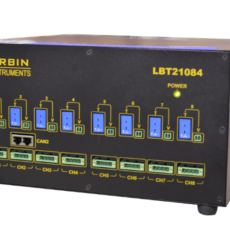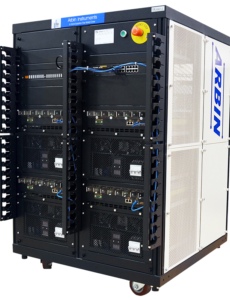Battery : Pack Testing Up To 1000 V
Overview
Pack Voltage up to 1000V
Max Power up to 1MW
A variety customized and standard solutions are available.Arbin offers battery pack testing systems for basic charge/discharge cycling, and simulating complex real-world applications such as drive profiles, cranking amp applications, and other custom profiles.
Arbin’s Regenerative Battery Testing (RBT) series is designed for testing high power battery packs. Today’s applications like electric vehicles, military technology, and stationary grid storage demand high-reliability and safe testing environments. The latest generation of Arbin’s RBT series has improved thermal management, redundant microcontrollers to help ensure failsafe testing, and built-in UPS to help ensure proper shutdown sequence in the case of input power failure.
The dependability and safety of Arbin’s RBT products are core principles. The regenerative circuitry within the system allows power to be discharged back to the grid, providing a more economical test solution. A full range of customizable options are available. The RBT series is intended to provide a safe, economical, and high performance solution for high-power testing applications. All Arbin testing systems come with a PC preloaded with our MITS Pro and Data Watcher software for creating test profiles, real‐time data monitoring, and data plotting & analysis.
Primary Applications:
- Life Cycle Testing
- Electric Vehicle (EV) Drive Cycle Simulations
- Hybrid Pulse Power Characterization Test – HPPC
- Dynamic Stress Test – DST
- Worldwide Harmonized Light Vehicles Test Procedure – WLTP
- Cranking Amp Tests
- R&D of battery packs for electric vehicle and grid storage applications
- Validate internal battery management system via CANBus
Key Features:
- Fully independent test channels using true Bipolar circuitry guaranteeing no switching time between charge and discharge
- Regenerative circuitry discharges power back to the grid with THD <5%
- Each channel provides multiple current ranges with 16‐bit resolution
- Redundant embedded microcontrollers provide a safe environment, and allow fast data logging and control flexibility for the most advanced test requirements
- Any number of channels can be operated in parallel for increased current‐handling capacity
- Simulate real-world profiles directly from data files without programming
- Communicate with internal battery management system (BMS) via CANBus or other protocols
- Each channel in the test station is safely controlled by a user‐defined individual voltage clamp applied at the hardware level
- Systems are air-cooled so no additional facility infrastructure or regular maintenance is needed
- A wide array of auxiliary inputs/outputs are available for additional data collection or control such as temperature monitoring, cell voltage monitoring, and more
- Arbin’s advanced software package, MITS Pro, provides flexible scheduling, a user‐friendly interface, distributed system control, and data acquisition
- Software provides easy data analysis and plotting based in Data Watcher and Microsoft Excel
Safety :
- Multiple levels of fusing are provided inside the system for protection as the channel/board and power supply levels.
- A small UPS is built into the system for a controlled startup and shutdown
- Each channel module has a fully redundant microcontroller dedicated for safety monitoring.
- Arbin’s software has safety functions for entire tests, and for individual steps within a test to help the user avoid overcharging, over‐discharging, over‐heating, etc.
- Tests begin with a built‐in safety check of all control values.
Description
Specifications :
Measurement Resolution: 16-bit
Control Accuracy: <0.1%
Minimum Step Time: 100ms
Data Logging Rate: 200 points per second, per system
Connection for PC: TCP/IP (Ethernet)
Ventilation Method: air-cooled with variable speed fans
Arbin Instruments provides a wide variety of auxiliary modules for expanding the capability of the main charge/discharge control circuitry. Modules are placed in a small external chassis. This makes it easy to manage auxiliaries with the battery pack, and add auxiliary channels to existing systems.
 |
 Arbin offers Auxiliary Voltage Inputs that can be used to monitor the individual cell voltages within a module. Data logged from auxiliary voltage inputs can be flexibly assigned by the user to one, many, or all of the main charge/discharge channels. Measurements can be used to control the test, act as safety limits, or simply record data. Arbin offers Auxiliary Voltage Inputs that can be used to monitor the individual cell voltages within a module. Data logged from auxiliary voltage inputs can be flexibly assigned by the user to one, many, or all of the main charge/discharge channels. Measurements can be used to control the test, act as safety limits, or simply record data. |
 |
 Temperature Measurement Inputs are offered for Type-T or K Thermocouple, or 10kohm or PT100 Thermistor sensors. Temperature data logged from these inputs can be flexibly assigned by the user to one, many, or all of the main charge/discharge channels. Temperature can be used to control the test, act as safety limits, or simply record temperature measurements. Temperature Measurement Inputs are offered for Type-T or K Thermocouple, or 10kohm or PT100 Thermistor sensors. Temperature data logged from these inputs can be flexibly assigned by the user to one, many, or all of the main charge/discharge channels. Temperature can be used to control the test, act as safety limits, or simply record temperature measurements. |
 |
 The CANBus option allow the Arbin tester to communicate with an internal battery management system (BMS) within the battery pack. The CANBus interface will allow the Arbin system to both send and receive CAN messages. It can read and record the messages from BMS, and messages from the BMS can be used to dynamically control the Arbin tester. (i.e. charge based on a CAN signal.) There are no 3rd party DLL packages or licenses required. The CANBus option allow the Arbin tester to communicate with an internal battery management system (BMS) within the battery pack. The CANBus interface will allow the Arbin system to both send and receive CAN messages. It can read and record the messages from BMS, and messages from the BMS can be used to dynamically control the Arbin tester. (i.e. charge based on a CAN signal.) There are no 3rd party DLL packages or licenses required. |
 |

Arbin EV Battery Pack Tester with Chamber
This module allow’s the Arbin tester to interface with approved 3rd party temperature/environmental chambers from other manufacturers. The Arbin software can turn the chamber on/off and adjust temperature during testing. Temperature setpoints from the chamber controller are automatically logged in the data and independent temperature measurements are available using thermocouple or thermistor inputs. |
 |
 Digital and Analog Input/Output channels are offered to interact with external hardware devices. Digital and Analog Input/Output channels are offered to interact with external hardware devices.
— The Digital I/O will send and receive a simple on/off, high/low relay signal. It can activate a BMS, receive a confirmation signal, and many other options.
— The Analog I/O will control any device that operates in a 0(2)-10V signal such as pumps, valves, etc. |
 |
 The Uninterrupted Power Supply (UPS) option will provide backup power to the PC with your Arbin system. It allows the test to automatically pause and wait for power to be restored to the tester and will automatically and safely resume testing after brief outages. Otherwise, the software and PC will safely be shut down. The Uninterrupted Power Supply (UPS) option will provide backup power to the PC with your Arbin system. It allows the test to automatically pause and wait for power to be restored to the tester and will automatically and safely resume testing after brief outages. Otherwise, the software and PC will safely be shut down. |
 |
 The Redundant Safety Monitoring System (RSMS) can be placed in series with any battery tester including those from USA, Europe, and Asia. The RSMS allows users to set a limit for Voltage, Current, Power, and Temperature that will automatically disconnect the battery or device under test is a safety limit is reached. Many manufacture’s claim to have comprehensive safety features, but the RSMS guarantees and extra layer of protection to help prevent failure events. The Redundant Safety Monitoring System (RSMS) can be placed in series with any battery tester including those from USA, Europe, and Asia. The RSMS allows users to set a limit for Voltage, Current, Power, and Temperature that will automatically disconnect the battery or device under test is a safety limit is reached. Many manufacture’s claim to have comprehensive safety features, but the RSMS guarantees and extra layer of protection to help prevent failure events. |


 Arbin offers
Arbin offers

 The
The


 Digital and Analog Input/Output
Digital and Analog Input/Output




Reviews
There are no reviews yet.